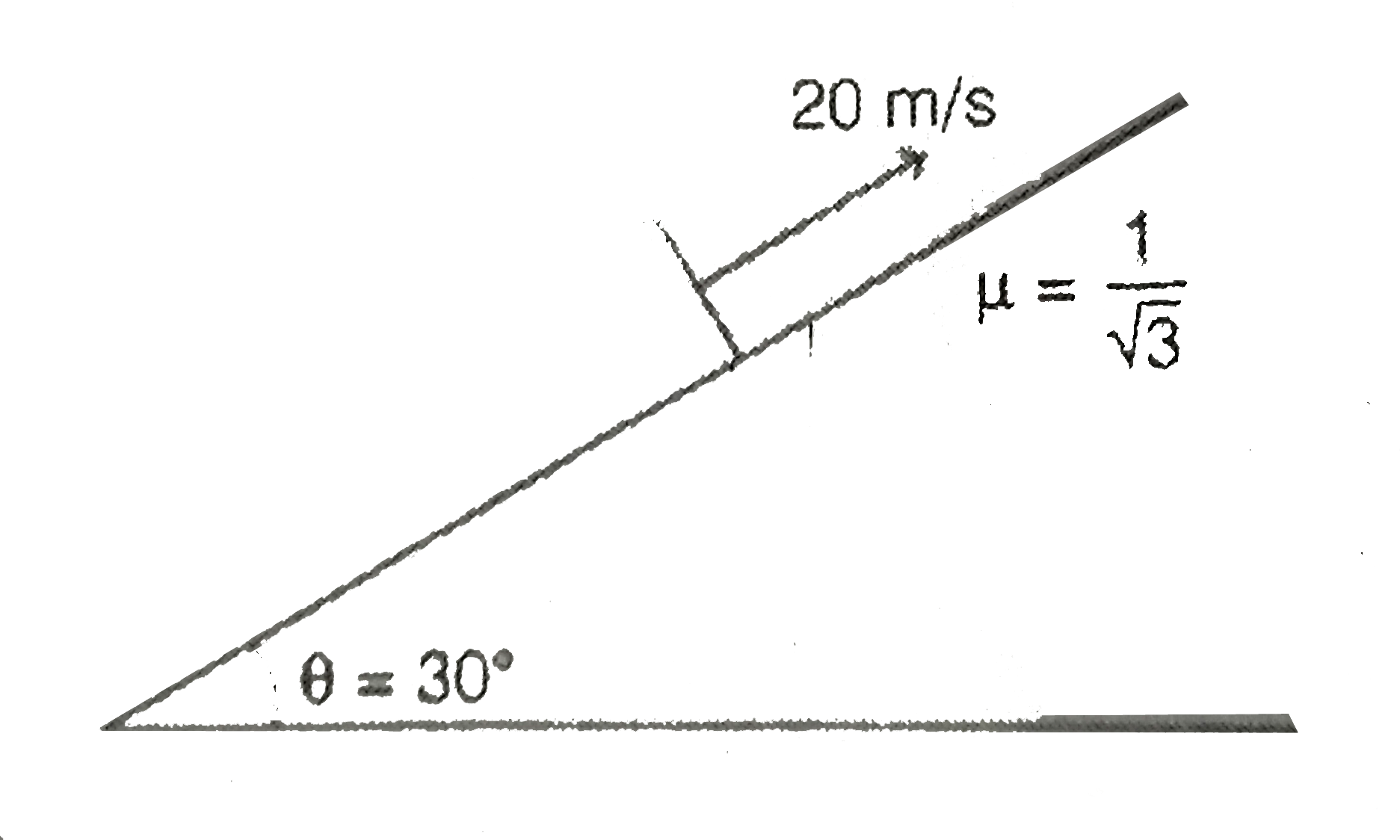A particle is projected up the inclined such that its component of velocity along the incline is 10m/s. Time of flight is 2 sec and maximum height above the incline is 5m. Then velocity of projection will be
10m/s
10√2m/s
5√5m/s
none
The correct Answer is:B
To solve the problem step by step, we will analyze the motion of the particle projected up an inclined plane.
Step 1: Identify the Given Information
- Component of velocity along the incline, V∥=10m/s
- Time of flight, t=2s
- Maximum height above the incline, h=5m
Step 2: Analyze the Motion
The motion can be divided into two components:
1. Along the incline (parallel to the incline)
2. Perpendicular to the incline (vertical direction)
Step 3: Time to Reach Maximum Height
Since the total time of flight is 2 seconds, the time taken to reach the maximum height is half of that:
tup=t2=1s
Step 4: Use the Vertical Motion Equation
At maximum height, the vertical component of the velocity becomes zero. The vertical component of the initial velocity can be expressed as:
Vvertical=Vsinθ
Using the equation of motion:
V=u+at
Where:
- V=0 (at maximum height)
- a=−g (acceleration due to gravity)
- t=1s
Thus, we have:
0=Vsinθ−g⋅tup
Vsinθ=g⋅1
Vsinθ=g
Step 5: Use the Maximum Height Equation
The maximum height h can also be expressed using the vertical component of the initial velocity:
h=Vsinθ⋅tup−12gt2up
Substituting tup=1s:
5=Vsinθ⋅1−12g⋅12
5=Vsinθ−g2
Substituting Vsinθ=g:
5=g−g2
5=g2
g=10m/s2
Step 6: Use the Horizontal Component of Velocity
We know that:
Vcosθ=10m/s
Step 7: Combine the Equations
Now we have two equations:
1. Vsinθ=g=10m/s2
2. Vcosθ=10m/s
Step 8: Square and Add the Equations
Squaring both equations and adding them:
(Vsinθ)2+(Vcosθ)2=(10)2+(10)2
V2(sin2θ+cos2θ)=100+100
Since sin2θ+cos2θ=1:
V2=200
V=√200=10√2m/s
Final Answer
The velocity of projection V is:
10√2m/s
- Component of velocity along the incline, V∥=10m/s
- Time of flight, t=2s
- Maximum height above the incline, h=5m
The motion can be divided into two components:
1. Along the incline (parallel to the incline)
2. Perpendicular to the incline (vertical direction)
Since the total time of flight is 2 seconds, the time taken to reach the maximum height is half of that:
tup=t2=1s
At maximum height, the vertical component of the velocity becomes zero. The vertical component of the initial velocity can be expressed as:
Vvertical=Vsinθ
Using the equation of motion:
V=u+at
Where:
- V=0 (at maximum height)
- a=−g (acceleration due to gravity)
- t=1s
0=Vsinθ−g⋅tup
Vsinθ=g⋅1
Vsinθ=g
The maximum height h can also be expressed using the vertical component of the initial velocity:
h=Vsinθ⋅tup−12gt2up
Substituting tup=1s:
5=Vsinθ⋅1−12g⋅12
5=Vsinθ−g2
Substituting Vsinθ=g:
5=g−g2
5=g2
g=10m/s2
We know that:
Vcosθ=10m/s
Now we have two equations:
1. Vsinθ=g=10m/s2
2. Vcosθ=10m/s
Squaring both equations and adding them:
(Vsinθ)2+(Vcosθ)2=(10)2+(10)2
V2(sin2θ+cos2θ)=100+100
Since sin2θ+cos2θ=1:
V2=200
V=√200=10√2m/s
The velocity of projection V is:
10√2m/s
Topper's Solved these Questions
Similar Questions
A particle is projected with a speed of 10 m/s at an angle 37∘ with the vertical. Find (i) time of flight (ii) maximum height above ground (iii) horizontal range.
View SolutionA projectile is projected from ground with an initial velocity (5ˆi+10ˆj)m/s If the range of projectile is R m, time of flight is Ts and maximum height attained above ground is Hm, find the numerical value of R×HT. [Take g=10m/s2]
View SolutionAn arrow is shot in air, its time of flight is 5 sec and horizontal range is 200 m. the inclination of the arrow with the horizontal is
View SolutionAn arrow is projected into air. It's time of flight is 5seconds and range 200m. , the vertical component of the velocity is:-
View SolutionA stone is projected in air. Its time of flight is 3s and range is 150m. Maximum height reached by the stone is (Take, g=10ms−2)
View SolutionAn arrow is projected into air. It's time of flight is 5seconds and range 200m. , the maximum height attained by the arrow is:-
View SolutionA particle is projected from the bottom of an inclined plane of inclination 30∘ with velocity of 40m/s at an angle of 60∘ with horizontal. Find the speed of the particle when its velocity vector is parallel to the plane. Take g=10m/s2.
View SolutionA body is projected up along the rough inclined plane from the bottom with some velocity. It travels up the incline and then returns back. If the time of ascent is ta and time of descent is td then
View SolutionA block is projected upwards on a rough inclined plane at 20 m/s. let the time in going up, then is equal to

View SolutionA particle is fired horizontally form an inclined plane of inclination 30 ∘ with horizontal with speed 50 m s − 1 . If g = 10 m s − 2 , the range measured along the incline is
View Solution
